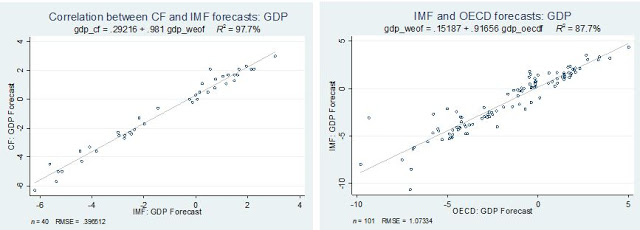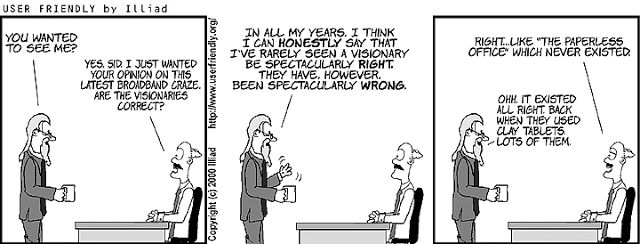Showing posts with label Forecasting Forum. Show all posts
Tuesday, December 13, 2016
Forecast Errors and Uncertainty Shocks
Macroeconomic forecasts are persistently too optimistic. This paper finds that common factors related to general uncertainty about U.S. macrofinancial prospects and global demand drive this overoptimism. These common factors matter most for advanced economies and G- 20 countries. The results suggest that an increase in uncertainty-driven overoptimism has dampening effects on next-year real GDP growth rates. This implies that incorporating the common structure governing forecast errors across countries can help improve subsequent forecasts.
For details, see the new IMF Working Paper.
Macroeconomic forecasts are persistently too optimistic. This paper finds that common factors related to general uncertainty about U.S. macrofinancial prospects and global demand drive this overoptimism. These common factors matter most for advanced economies and G- 20 countries. The results suggest that an increase in uncertainty-driven overoptimism has dampening effects on next-year real GDP growth rates. This implies that incorporating the common structure governing forecast errors across countries can help improve subsequent forecasts.
For details,
Posted by at 2:37 PM
Labels: Forecasting Forum
Saturday, September 24, 2016
Will Trump Win?
The view of a professor who has predicted the last eight elections accurately.
The view of a professor who has predicted the last eight elections accurately.
Posted by at 2:47 PM
Labels: Forecasting Forum
Wednesday, August 10, 2016
How Accurate Are Private Sector Fiscal Forecasts? Evidence from the Great Recession
Government fiscal forecasts invoke considerable skepticism: Frankel (2012), for instance, calls them “wishful thinking” and advocates the use of private forecasts as a reality check. This recommendation leads to an obvious question: how good are the private sector’s fiscal forecasts? We assess the quality of forecasts of the government budget balance made by the private sector for nine advanced economies between 1993 and 2013, with a special focus on the Great Recession period. Our main findings can be summarized as follows. First, we show that private sector budget balance forecasts typically display bias towards ‘optimism’ but the extent of the bias differs across countries. Second, we find that budget balance forecasts exhibit ‘information rigidity’; that is, revisions to forecasts tend to be smooth. This tendency proves costly around turning points in the economy, which we illustrate here using the forecast errors made during the Great Recession. To conclude, while it is a good idea to complement government fiscal forecasts with those from the private sector, there are steps that the private sector could also take to improve the quality of its own forecasts.
For details, see my paper published in the 21st Federal Forecasters Conference Proceedings.
Government fiscal forecasts invoke considerable skepticism: Frankel (2012), for instance, calls them “wishful thinking” and advocates the use of private forecasts as a reality check. This recommendation leads to an obvious question: how good are the private sector’s fiscal forecasts? We assess the quality of forecasts of the government budget balance made by the private sector for nine advanced economies between 1993 and 2013, with a special focus on the Great Recession period. Our main findings can be summarized as follows.
Posted by at 5:27 PM
Labels: Forecasting Forum
Monday, February 1, 2016
A Groundhog Day Tradition: The Stekler Award for Courage in Forecasting
The Stekler Award is named after the famous forecasting expert and academic Herman Stekler who believes that recessions should be forecast “early and often.” In practice, recessions are almost never forecast in advance. The Economist recently re-discovered this long-standing finding and highlighted the poor record of the IMF in forecasting recessions. The record of other public institutions or the private sector is just as poor. For instance, see the charts below on forecasts made by the IMF, OECD and the private sector (labeled ‘CF’ in the charts) over the course of 2009—each point shows the forecast for a particular country. The forecasts are virtually identical. And the forecasts for recessions (negative growth) were not made in advance by any of the sources.
The race is on for the 2017 award. Suggestions are welcome and can be sent to ploungani@gmail.com. The Stekler Award recognizes forecasts that depart significantly from the consensus view. Predictions need not be restricted to forecasts of recessions but they must be specific (so “oil prices will rebound someday” doesn’t cut it) and well reasoned (so no “we have been on the path to doom which is bound to come one day”-type of forecasts).
We mined a recent article in Politico to see if we could get some front runners for the 2017 award. There were a range of predictions, some quite clever (Dean Baker predicted that during 2016, unlike 2015, oil prices would not fall another $60 a barrel), some specific (Ann Harrison predicts that “India will replace China as the leading destination for foreign investment” in 2016), most quite gloomy. On the U.S. economy in 2016, most experts surveyed stuck to the center, though Robert Reich said: “I expect the U.S. economy to sputter in 2016”; if he’d been a little more specific he ‘coulda been a contender’.
The 2016 Stekler Award for Courage in Forecasting goes to Michael (“Mish”) Shedlock. At the start of 2015, the blogger popularly known as “Mish” had predicted recessions in Canada and the United States during 2015. While these events did not come to pass, enough anxiety was generated about the health of these economies over the course of the year that Mish deserves some credit for anticipating a degree of weakness that was not being widely talked about at the start of last year. Read the full article…
Posted by at 6:21 PM
Labels: Forecasting Forum
Wednesday, January 27, 2016
“Growth is devilishly hard to predict”
But as Drum noted in the Economist article, “Despite forecasters’ best efforts, growth is devilishly hard to predict”.
Last year, in September, my presentation at the Federal Forecasters Conference summarized my work on the inability or unwillingness of forecasters to predict recessions. I suggested that to get forecasters to predict recessions (even inaccurately) we should have a Stekler Award for Courage in Forecasting. The award would be in honor of noted forecaster Herman Stekler who says that forecasters should predict recessions early and often and that he himself has predicted 9 of the last 5 recessions.
For my recent work on forecast accuracy see the following:
- September 2015: Fail Again? Fail Better? On the Inability to Forecast Recessions
- April 2014: “There will be growth in the spring”: How well do economists predict turning points?
Kevin Drum–a political blogger for Mother Jones–asks: “But I wonder who did better at predicting recessions? Goldman Sachs? The CIA? A hedge fund rocket scientist in Connecticut? Whoever it is, it sounds like the IMF might want to look them up.”
But as Drum noted in the Economist article, “Despite forecasters’ best efforts, growth is devilishly hard to predict”.
Last year, in September, my presentation at the Federal Forecasters Conference summarized my work on the inability or unwillingness of forecasters to predict recessions.
Posted by at 9:35 PM
Labels: Forecasting Forum
Subscribe to: Posts


